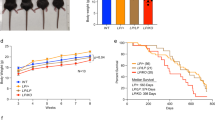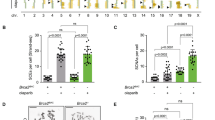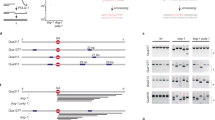Abstract
The BRCA2 tumour suppressor protein is involved in maintaining genetic stability through its role in homologous recombination (HR), where it mediates RAD51-dependent strand invasion. Here, we show that BRCA2-defective cells are not completely impaired in HR by strand invasion although the spontaneous HR rate is 10-fold lower than that in wild-type cells. Furthermore, a DNA double-strand break (DSB) triggers HR repair by strand invasion also in BRCA2-defective cells, but less efficiently. Thus, either the strand invasion pathway(s) in which BRCA2 operates is still operative in the absence of a functional BRCA2, albeit at a reduced frequency, or there is a separate pathway for strand invasion still functional in BRCA2-deficient cells. Consistent with the latter hypothesis, we show that HR events occurring in BRCA2-defective cells differ from HR events in wild-type cells. These data suggest that BRCA2-defective hamster cells are impaired in short tract gene conversion but maintain proficiency in sister chromatid exchange.
This is a preview of subscription content, access via your institution
Access options
Subscribe to this journal
Receive 50 print issues and online access
$259.00 per year
only $5.18 per issue
Buy this article
- Purchase on Springer Link
- Instant access to full article PDF
Prices may be subject to local taxes which are calculated during checkout



Similar content being viewed by others
References
Arnaudeau C, Lundin C and Helleday T . (2001). J. Mol. Biol., 307, 1235–1245.
Baumann P, Benson FE and West SC . (1996). Cell, 87, 757–766.
Chen PL, Chen CF, Chen Y, Xiao J, Sharp ZD and Lee WH . (1998). Proc. Natl. Acad. Sci. USA, 95, 5287–5292.
Connor F, Bertwistle D, Mee PJ, Ross GM, Swift S, Grigorieva E, Tybulewicz VL and Ashworth A . (1997). Nat. Genet., 17, 423–430.
Davies AA, Masson JY, McIlwraith MJ, Stasiak AZ, Stasiak A, Venkitaraman AR and West SC . (2001). Mol. Cell, 7, 273–282.
Friedman LS, Thistlethwaite FC, Patel KJ, Yu VP, Lee H, Venkitaraman AR, Abel KJ, Carlton MB, Hunter SM, Colledge WH, Evans MJ and Ponder BA . (1998). Cancer Res., 58, 1338–1343.
Johnson RD and Jasin M . (2000). EMBO J., 19, 3398–3407.
Johnson RD, Liu N and Jasin M . (1999). Nature, 401, 397–399.
Kraakman-van der Zwet M, Overkamp WJ, van Lange RE, Essers J, van Duijn-Goedhart A, Wiggers I, Swaminathan S, van Buul PP, Errami A, Tan RT, Jaspers NG, Sharan SK, Kanaar R and Zdzienicka MZ . (2002). Mol. Cell. Biol., 22, 669–679.
Larminat F, Germanier M, Papouli E and Defais M . (2002). Oncogene, 21, 5188–5192.
Marmorstein LY, Ouchi T and Aaronson SA . (1998). Proc. Natl. Acad. Sci. USA, 95, 13869–13874.
Mizuta R, LaSalle JM, Cheng HL, Shinohara A, Ogawa H, Copeland N, Jenkins NA, Lalande M and Alt FW . (1997). Proc. Natl. Acad. Sci. USA, 94, 6927–6932.
Moynahan ME, Pierce AJ and Jasin M . (2001). Mol. Cell, 7, 263–272.
Patel KJ, Yu VP, Lee H, Corcoran A, Thistlethwaite FC, Evans MJ, Colledge WH, Friedman LS, Ponder BA and Venkitaraman AR . (1998). Mol. Cell, 1, 347–357.
Pellegrini L, Yu DS, Lo T, Anand S, Lee M, Blundell TL and Venkitaraman AR . (2002). Nature, 420, 287–293.
Richardson C and Jasin M . (2000). Nature, 405, 697–700.
Richardson C, Moynahan ME and Jasin M . (1998). Genes Dev., 12, 3831–3842.
Schultz N, Lopez E, Saleh-Gohari N and Helleday T . (2003). Nucleic Acids Res., 31, 4959–4964.
Shin DS, Pellegrini L, Daniels DS, Yelent B, Craig L, Bates D, Yu DS, Shivji MK, Hitomi C, Arvai AS, Volkmann N, Tsuruta H, Blundell TL, Venkitaraman AR and Tainer JA . (2003). EMBO J., 22, 4566–4576.
Sonoda E, Sasaki MS, Buerstedde JM, Bezzubova O, Shinohara A, Ogawa H, Takata M, Yamaguchi-Iwai Y and Takeda S . (1998). EMBO J., 17, 598–608.
Suzuki A, de la Pompa JL, Hakem R, Elia A, Yoshida R, Mo R, Nishina H, Chuang T, Wakeham A, Itie A, Koo W, Billia P, Ho A, Fukumoto M, Hui CC and Mak TW . (1997). Genes Dev., 11, 1242–1252.
Tarsounas M, Davies D and West SC . (2003). Oncogene, 22, 1115–1123.
Tutt A, Bertwistle D, Valentine J, Gabriel A, Swift S, Ross G, Griffin C, Thacker J and Ashworth A . (2001). EMBO J., 20, 4704–4716.
Tutt A, Gabriel A, Bertwistle D, Connor F, Paterson H, Peacock J, Ross G and Ashworth A . (1999). Curr. Biol., 9, 1107–1110.
Venkitaraman AR . (2002). Cell, 108, 171–182.
Wong AK, Pero R, Ormonde PA, Tavtigian SV and Bartel PL . (1997). J. Biol. Chem., 272, 31941–31944.
Xia F, Taghian DG, DeFrank JS, Zeng ZC, Willers H, Iliakis G and Powell SN . (2001). Proc. Natl. Acad. Sci. USA, 98, 8644–8649.
Yu VP, Koehler M, Steinlein C, Schmid M, Hanakahi LA, van Gool AJ, West SC and Venkitaraman AR . (2000). Genes Dev., 14, 1400–1406.
Acknowledgements
We thank Malgorzata Zdzienicka and Maria Jasin for materials and Mark Meuth and members of the Helleday laboratory for help and valuable discussions. The Biological & Biotechnological Sciences Research Council, the Swedish Cancer Society, the Swedish Research Council, the Swedish Agency for Animal Welfare and Yorkshire Cancer Research supported this work financially. NSG has a scholarship from the Kerman University of Medical Science, Iran.
Author information
Authors and Affiliations
Corresponding author
Rights and permissions
About this article
Cite this article
Saleh-Gohari, N., Helleday, T. Strand invasion involving short tract gene conversion is specifically suppressed in BRCA2-deficient hamster cells. Oncogene 23, 9136–9141 (2004). https://doi.org/10.1038/sj.onc.1208178
Received:
Revised:
Accepted:
Published:
Issue Date:
DOI: https://doi.org/10.1038/sj.onc.1208178
Keywords
This article is cited by
-
NF-κB-dependent DNA damage-signaling differentially regulates DNA double-strand break repair mechanisms in immature and mature human hematopoietic cells
Leukemia (2015)
-
The role of BRCA1 in homologous recombination repair in response to replication stress: significance in tumorigenesis and cancer therapy
Cell & Bioscience (2013)
-
BRCA1 and CtIP suppress long-tract gene conversion between sister chromatids
Nature Communications (2013)
-
The role of BRCA2 in replication-coupled DNA interstrand cross-link repair in vitro
Nature Structural & Molecular Biology (2006)



